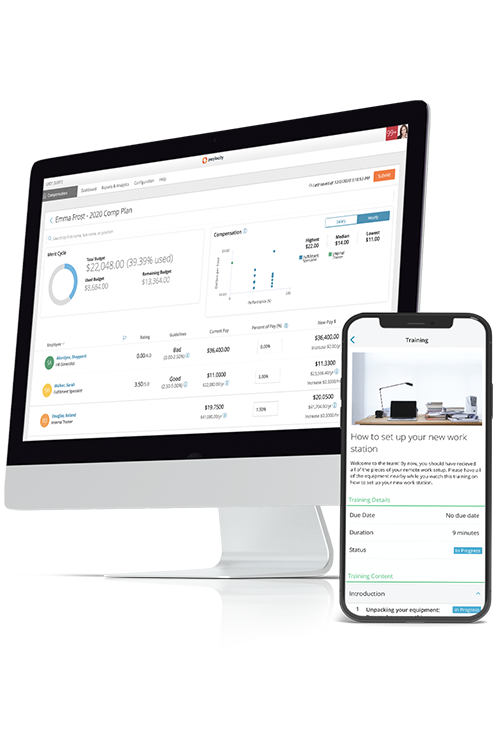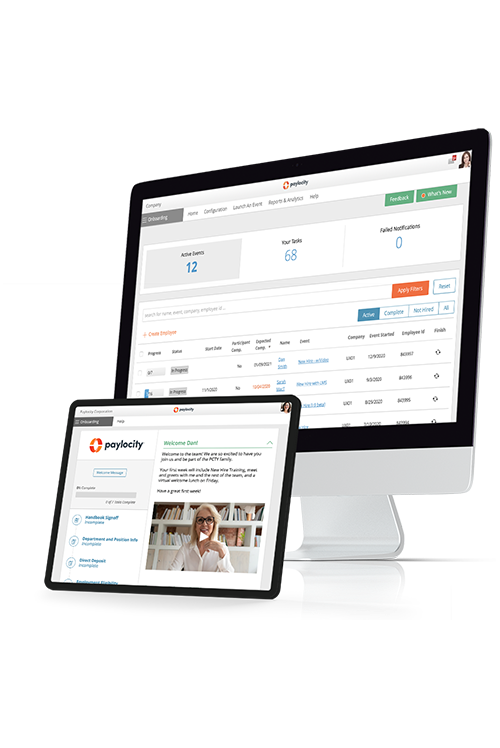resources
Modern Onboarding Process: What Do New Hires Want and Need?
June 21, 2021
When considering your employee onboarding software, you need a solution that will help you organize the process and streamline it. Learn how Paylocity can help.
Blog Post

Did you know that 33% of employees quit their jobs within the first three months? There are a few reasons why employees leave. Some cite company culture, but a full 43% say that their day-to-day duties were not what they expected in the hiring process. Employee turnover can cost your company as much as two times the employee’s salary. One key way that your company can improve these numbers is by developing onboarding processes that meet employees’ needs.
When considering your employee onboarding software, you need a solution that will help you organize and streamline the process. While the solution should help gather all the information you need, it also needs to help your company deliver the right experience to boost employee engagement. Onboarding isn't only about making sure the employee is trained quickly to help your company. The real goal of any modern onboarding program is helping that employee build a foundation for success in your company.
What is the employee onboarding process?
Onboarding is the process to help new hires acclimate to their position. This includes supporting them, providing tools they need to become productive, and helping them become a member of the team and company culture. The onboarding process is the protocol your company uses to welcome new hires. There are a lot of tasks that need to be handled during onboarding. Employees may need to fill out new hire paperwork, provide tax information, and make choices about benefits. There might be onboarding training based on their position, and regulatory compliance training, such as safety training.
The administrative part of the process is important, but it's not the primary goal of your onboarding process. The real objective of a modern employee experience is to help the employee adapt to the position and company culture. Employees start to learn about the company during this process and it should help them to understand their role, become familiar with their colleagues, and gain support to help them excel in their new position.
What do new hires want from their onboarding experience?
During the onboarding process, employees want to understand how to access the tools they need to succeed in the position. New hires will have questions about protocol and processes, no matter what level they're at. Your company has its own culture. Everything is new to the employee. While this can (and should!) be an exciting time, starting a new job is also stressful for many new hires. They're unsure of what is expected in their new position.
Managers should take some time to empathize with new hires. Everyone had first-day nervousness. Even for new hires who have a great deal of experience, there may be new programs to learn and different protocols to navigate. While every person has their own preferences and personality, there are some very common things that most hires do want. You'll notice that most of these items are really a showing of support from the company. They are ways to help the employee excel at their job.
Over 70% of new hires indicate that they want one-on-one time with their direct manager. This is something to consider heavily. You've heard that employees don't leave jobs, they leave bad managers. The flip side of that coin is true, too. Many employees gauge their satisfaction in their job by their working relationship with their manager. This isn't really surprising, as people want to know that they're working for a manager that's fair, helpful, and supportive.
Other items that many new hires want include detailed plans for their duties over the coming weeks, an understanding of performance goals, and information on the company, mission statement, and culture.
What does the onboarding process consist of?
The onboarding process includes collecting data, such as contact information, identification, tax information, direct deposit information, and any contract or benefit paperwork. It also includes a company handbook, information on the company, training for the position, and welcoming them to the company culture.
When we talk about onboarding, most people think of the initial process when a new hire starts. This might include initial training and a probationary period. While that is a big part of onboarding, it's only the first phase for that employee. Onboarding should be an ongoing process during the entire lifecycle of that employee's time with your company.
The initial onboarding phase includes collecting employee information, helping them understand their job and responsibilities, and introducing them to company culture. You would have them review the employee handbook and discuss details about their pay, benefits, schedule, and other aspects of their new position.
The initial training phase should last as long as it takes to help the employee become confident in their position. For long-term employees, there may be multiple onboarding processes. Any time an employee moves to a new position or receives a promotion, there should be an onboarding process to help them acclimate to those responsibilities. You may not call this onboarding, but it should include all of the same support and information. Though the employee already has the benefit of being familiar with the location and company culture.
Read our new hire onboarding guide for a full breakdown of what goes into a successful onboarding program.
What are the 4 phases of onboarding?
When you look at onboarding as an ongoing process, it's divided into four phases.
- The initial development phase is the first phase of onboarding for new hires. It's the process of helping them fit into the company and become productive in their position.
- Ongoing development is the next phase. This might include onboarding for promotions or opportunities for your employees to learn new skills to improve in their current position.
- Retention is a constant part of the onboarding process to help improve engagement and job satisfaction.
- Separation is the process of helping employees leave the company.
How long is the onboarding process?
The most common answer among HR professionals is that the initial onboarding process should take a minimum of three months. By the 90 day mark, most new employees are comfortable in their role and the physical location. While that's the most common answer, newer information indicates that onboarding should last longer than that to improve employee retention and increase engagement. The initial onboarding process might extend as long as the first year. Other phases of the onboarding process, including development, retention, and separation, last throughout the employee’s tenure at your company. Your HR Management System can help you organize the onboarding process and the entire lifecycle for every one of your employees.
Why is onboarding important?
Onboarding is one of the ways that new employees learn about their new job and company. It's a first impression of their future with your company. Moving forward, it becomes a key way to support employees, help them engage, and become team players. Learn how Paylocity can help you, onboard new employees, with our onboarding platform!




